Tertiary evolution of the São Vicente and Setúbal submarine canyons, Southwest Portugal: insights from seismic stratigraphy
Abstract
Key words: Southwest Iberian margin; Neogene; submarine canyons; turbidites; submarine fans. The Setúbal and São Vicente canyons are two major modern submarine canyons located in the southwest Iberian margin off Portugal. Although recognised as Pliocene to Quaternary features, their development during the Tertiary has not been fully understood up to date. A grid of 20 seismic data has been used to characterise the sedimentary deposits of the adjacent flanks to the submarine canyons. The relationship between the geological structure of the margin and the canyon's present location has been investigated. The interpretation of the main seismic units allowed the recognition of three generations of ravinements probably originated after middle Oligoccne. Six units grouped in two distinctive seismic sequences have been identified and correlated with offshore stratigraphic data. Seismic Sequence 2 (SS2), the oldest, overlies Mesozoic and upper Eocene deformed units. Seismic Sequence 1 (SS1) is composed of four different seismic packages separated from SS2 by an erosional surface. The base of the studied sediment ridges is marked by an extensive erosional surface derived from a early/middle Oligocene relative sea-level fall. Deposition in the adjacent area to the actual canyons was reinitiated in late Oligocene in the form of transgressive and channel-fill deposits. A new depositional hiatus is recorded onshore during the Burdigalian, coincident wilh the unconfonnity separating SSI and SS2. This can be correlated wilh the Arrábida unconformity and with the paroxysmal Burdigalian phase of the Betic domain. Presently, the Setúbal and São Vicente submarine canyons locally cut SS1 and SS2, forming distinctive channels from those recognised on the seismic data. On the upper shelf both dissect highly deformed areas subject to important erosion.Downloads
Published
2009-06-09
Issue
Section
Articles






